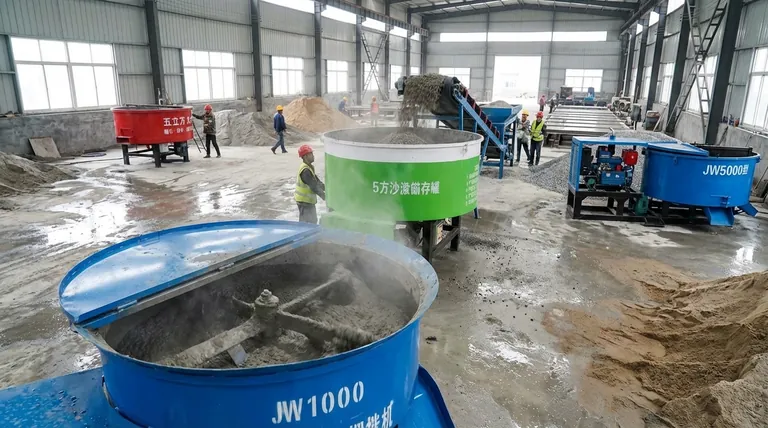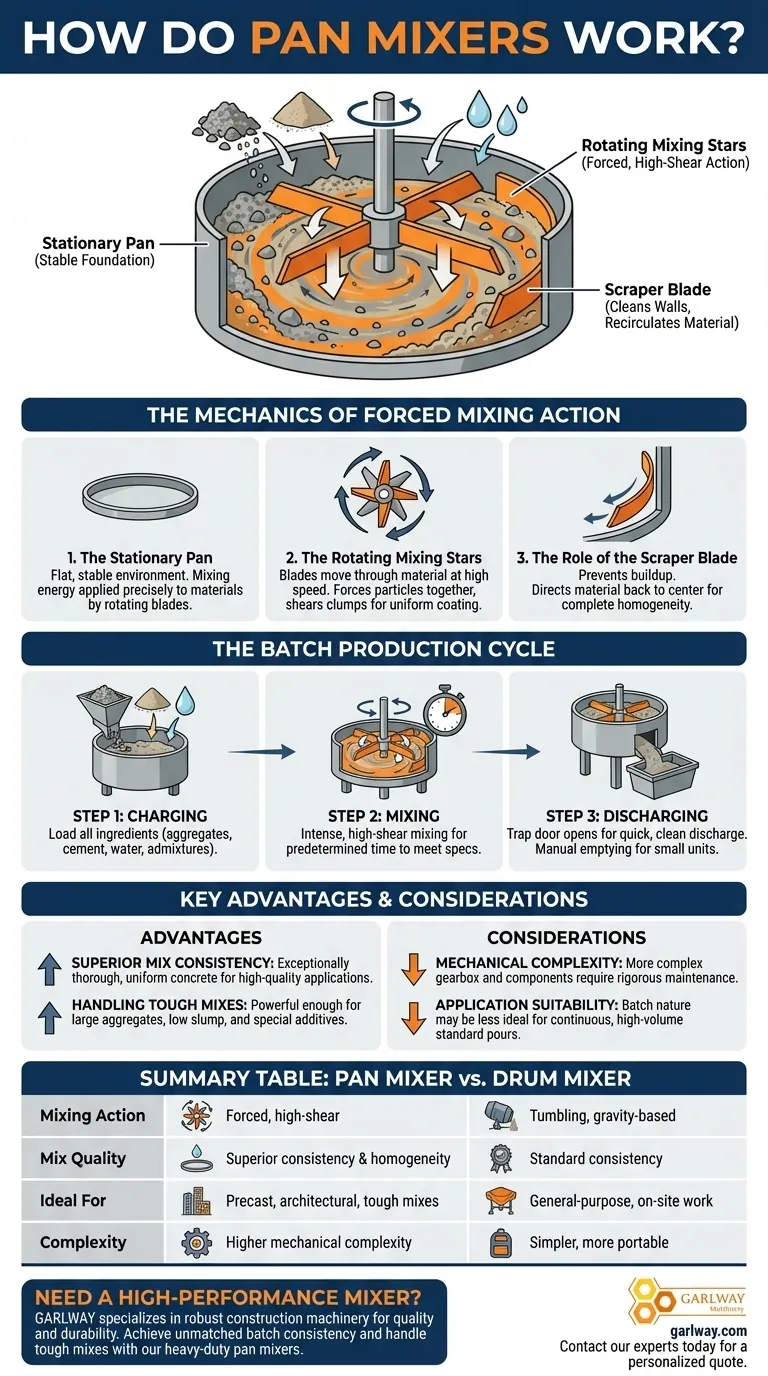At its core, a pan mixer works by using rotating blades, or paddles, inside a stationary cylindrical pan to force materials together. This high-shear, energetic action is fundamentally different from the tumbling motion of a drum mixer. A dedicated scraper blade constantly cleans the pan's walls, ensuring all material is continuously folded back into the active mixing zone for a completely homogenous blend.
A pan mixer is not a passive tumbler; it is an active, high-intensity machine. Its defining principle is forced mixing action, which guarantees a fast, consistent, and high-quality blend, making it the standard for applications where precision and strength are paramount.

The Mechanics of Forced Mixing Action
To truly understand a pan mixer, you must see it as a system of coordinated components designed for maximum efficiency and material interaction.
The Stationary Pan: A Stable Foundation
The pan itself is typically flat and stationary. This provides a stable, controlled environment where the mixing energy is applied directly and precisely to the materials by the rotating blades.
The Rotating Mixing Stars: The Heart of the Operation
The work is done by a set of mixing blades, often arranged in a "star" configuration, that rotate on a central vertical axis. These blades move through the aggregate, cement, and water at high speed.
This action forces particles together, shearing clumps and ensuring every grain of sand and piece of aggregate is coated with cement paste. This is a stark contrast to a drum mixer, which relies on gravity and a slower tumbling motion.
The Role of the Scraper Blade
A simple but critical component is the scraper blade. It is positioned to ride along the interior wall of the pan, preventing material buildup and directing it back toward the center to be re-incorporated by the main mixing blades.
The Batch Production Cycle
Pan mixers are batch mixers, meaning they produce concrete one distinct load at a time. This process allows for exceptional quality control.
Step 1: Charging the Mixer
The production cycle begins by loading all the necessary ingredients—aggregates, cement, water, and any admixtures—into the pan.
Step 2: The Mixing Phase
Once charged, the control system initiates the rotation of the mixing stars. The intense, high-shear mixing occurs for a predetermined amount of time, ensuring the batch meets exact specifications.
Step 3: Discharging the Concrete
After mixing is complete, a trap door in the bottom of the pan opens to discharge the finished concrete quickly and cleanly. For very small laboratory mixers, the blades may be lifted out so the entire pan can be removed and emptied manually.
Key Advantages and Considerations
The design of a pan mixer creates distinct advantages, but also brings specific considerations that make it suitable for certain jobs over others.
Advantage: Superior Mix Consistency
The forced mixing action is exceptionally thorough. It excels at producing high-quality, uniform concrete, which is essential for precast elements, architectural concrete, and other high-performance applications.
Advantage: Handling Tough Mixes
Pan mixers have the power to handle difficult or "tough" mixtures. This includes concrete with large aggregates, low slump (stiff) concrete, or mixes with special additives that require vigorous blending.
Consideration: Mechanical Complexity
The internal gearbox and multiple rotating components mean pan mixers can be more mechanically complex and require more rigorous maintenance than a simple drum mixer.
Consideration: Application Suitability
While unparalleled for quality, the batch nature and cost may make pan mixers less ideal for continuous, high-volume pours of standard-grade concrete where a simpler drum or truck mixer would be more economical.
Making the Right Choice for Your Goal
Selecting the right mixer depends entirely on the requirements of the final product.
- If your primary focus is high-performance precast concrete: The pan mixer is the definitive choice for its consistency and ability to handle complex, specialized mixes.
- If your primary focus is general-purpose, on-site concrete: A simpler and more portable drum mixer is often the more practical and cost-effective solution.
- If your primary focus is repeatable, high-quality batches: The pan mixer offers unmatched speed and quality control for applications that demand uniformity from one batch to the next.
Ultimately, understanding the pan mixer's forced mixing principle is the key to leveraging its power for precision concrete production.
Summary Table:
| Feature | Pan Mixer | Drum Mixer |
|---|---|---|
| Mixing Action | Forced, high-shear | Tumbling, gravity-based |
| Mix Quality | Superior consistency & homogeneity | Standard consistency |
| Ideal For | Precast, architectural, tough mixes | General-purpose, on-site work |
| Complexity | Higher mechanical complexity | Simpler, more portable |
Need a high-performance mixer for your demanding projects?
GARLWAY specializes in robust construction machinery designed for contractors who prioritize quality and durability. Our range of concrete mixers, including heavy-duty pan mixers, are engineered to deliver the superior, homogenous blends required for precast elements and architectural concrete.
Let us help you achieve unmatched batch consistency and handle tough mixes with ease. Contact our experts today to discuss the perfect mixer for your specific application and get a personalized quote.
Visual Guide

Related Products
- Ready Mixer Machine for Construction Ready Mix Machinery
- Commercial Construction Mixer Machine for Soil Cement Mixing Concrete
- Hydraulic Concrete Mixer Machine Cement Mixing Equipment for Mixture Concrete
- JZC500 Large Cement Mixer Machine Price for Concrete Mix
- Portable Electric Small Cement Mixer Concrete Machine
People Also Ask
- What safety considerations are important for concrete mixer operation? A Guide to Proactive Risk Management
- Can a concrete mixer be used for mortar? Understanding the trade-offs for your project
- Why is the manufacturer's strength and service important when choosing a concrete mixer? Ensure Long-Term Project Success
- Which type of projects require a concrete mixer? Essential Guide for Construction Pros
- What is the function of a concrete mixer machine? Achieve Consistent, High-Quality Concrete for Your Projects



















